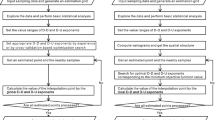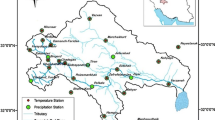Abstract
Interpolation techniques for spatial data have been applied frequently in various fields of geosciences. Although most conventional interpolation methods assume that it is sufficient to use first- and second-order statistics to characterize random fields, researchers have now realized that these methods cannot always provide reliable interpolation results, since geological and environmental phenomena tend to be very complex, presenting non-Gaussian distribution and/or non-linear inter-variable relationship. This paper proposes a new approach to the interpolation of spatial data, which can be applied with great flexibility. Suitable cross-variable higher-order spatial statistics are developed to measure the spatial relationship between the random variable at an unsampled location and those in its neighbourhood. Given the computed cross-variable higher-order spatial statistics, the conditional probability density function is approximated via polynomial expansions, which is then utilized to determine the interpolated value at the unsampled location as an expectation. In addition, the uncertainty associated with the interpolation is quantified by constructing prediction intervals of interpolated values. The proposed method is applied to a mineral deposit dataset, and the results demonstrate that it outperforms kriging methods in uncertainty quantification. The introduction of the cross-variable higher-order spatial statistics noticeably improves the quality of the interpolation since it enriches the information that can be extracted from the observed data, and this benefit is substantial when working with data that are sparse or have non-trivial dependence structures.





Similar content being viewed by others
Notes
Due to confidentiality issues, drill-hole samples are uniformly coloured in the map, i.e. specific values of Cu and S are not displayed.
As pointed out by Li et al. (2010), ordinary kriging is the most widely used geostatistical method, producing the best linear unbiased predictions.
References
Arpat B, Caers J (2007) Conditional simulation with patterns. Math Geosci 39:177–203
Babak O (2013) Inverse distance interpolation for facies modeling. Stoch Environ Res Risk Assess. doi:10.1007/s00477-013-0833-8
Babak O, Deutsch CV (2009) Statistical approach to inverse distance interpolation. Stoch Environ Res Risk Assess 23:543–553
Bárdossy A (2006) Copula-based geostatistical models for groundwater quality parameters. Water Resour Res 42:W11416
Bárdossy A, Li J (2008) Geostatistical interpolation using copulas. Water Resour Res 44:W07412
Boucher A (2009) Considering complex training images with search tree partitioning. Comput Geosci 35:1151–1158
Chatterjee S, Dimitrakopoulos R (2012) Multi-scale stochastic simulation with a wavelet-based approach. Comput Geosci 45:177–189
Chilès JP, Delfiner P (1999) Geostatistics—modeling spatial uncertainty. Wiley, New York
Chugunova TL, Hu LY (2008) Multiple point simulations constrained by continuous auxiliary data. Math Geosci 40:133–146
Cressie N (1985) Fitting variogram models by weighted least squares. Math Geol 17:563–586
De Iaco S (2013) On the use of different metrics for assessing complex pattern reproductions. J Appl Stat. doi:10.1080/02664763.2012.754853
Dimitrakopoulos R, Mustapha H, Gloaguen E (2010) High-order statistics of spatial random fields: exploring spatial cumulants for modelling complex, non-Gaussian and non-linear phenomena. Math Geosci 42:65–99
Gaetan C, Guyon X (2010) Spatial statistics and modeling. Springer, New York
Gloaguen E, Dimitrakopoulos R (2008) Conditional wavelet based simulation of nonstationary geology using geophysical and model analogue information. Paper presented at the Proceedings of Geostats 2008—VIII International Geostatistics Congress, Santiago, Chile
Gloaguen E, Dimitrakopoulos R (2009) Two-dimensional conditional simulations based on the wavelet decomposition of training images. Math Geosci 41:679–701
Goodfellow R, Mustapha H, Dimitrakopoulos R (2012) Approximations of high-order spatial statistics through decomposition. Quant Geol Geostat, Geostat Oslo 17:91–102. doi:10.1007/978-94-007-4153-9_8
Honarkhah M, Caers J (2010) Stochastic simulation of patterns using distance-based pattern modelling. Math Geosci 42:487–517
Hosny KM (2007) Exact Legendremoment computation for gray level images. Pattern Recogn 40:3597–3605
Hwang Y, Clark M, Rajagopalan B, Leavesley G (2012) Spatial interpolation schemes of daily precipitation for hydrologic modeling. Stoch Environ Res Risk Assess 26:295–320
Kazianka H (2013) Approximate copula-based estimation and prediction of discrete spatial data. Stoch Environ Res Risk Assess 27:2015–2026
Kazianka H, Pilz J (2010a) Copula-based geostatistical modeling of continuous and discrete data including covariates. Stoch Environ Res Risk Assess 24:661–673
Kazianka H, Pilz J (2010b) Spatial interpolation using copula-based geostatistical models. In: Atkinson P, Lloyd C (eds) geoENV VII—Geostatistics for environmental applications. Springer, Berlin
Kazianka H, Pilz J (2011) Bayesian spatial modeling and interpolation using copulas. Comput Geosci 37:310–319
Kazianka H, Pilz J (2012) Objective Bayesian analysis of spatial data with uncertain nugget and range parameters. Can J Stat 40:304–327
Kim JH, Wong K, Athanasopoulos G, Liu S (2011) Beyond point forecasting: evaluation of alternative prediction intervals for tourist arrivals. Int J Forecasting 27:887–901
Kleijnen JPC, Mehdad E, Beers WCM (2012) Convex and monotonic bootstrapped kriging. Proceedings of the 2012 Winter Simulation Conference
Li M, Shao Q, Renzullo L (2010) Estimation and spatial interpolaiton of rainfall intensity distribution form the effective rate of precipitation. Stoch Environ Res Risk Assess 24:117–130
Liu J, Spiegel MR (1999) Mathematical handbook of formulas and tables, 2nd edn. McGraw-Hill, New York
Loh JM, Stein ML (2004) Bootstrapping a spatial point process. Stat Sinica 14:69–101
Loh JM, Stein ML (2008) A valid and fast spatial bootstrap for correlation functions. Astrophys J 681:726–734
Machuca-Mory DF, Dimitrakopoulos R (2012) Simulation of a structurally-controlled gold deposit using high-order statistics. Paper presented at the Ninth International Geostatistics Congress, Oslo, Norway
Mirowski PW, Trtzlaff DM, Davies RC, McCormick DS, Williams N, Signer C (2008) Stationary scores on training images for multipoint geostatistics. Math Geosci 41:447–474
Mukul M, Roy D, Satpathy S, Kumar VA (2004) Bootstrapped spatial statistics: a more robust approach to the analysis of finite strain data. J Struct Geol 26:595–600
Mustapha H, Dimitrakopoulos R (2010a) A new approach for geological pattern recognition using high-order spatial cumulants. Comput Geosci 36:313–343
Mustapha H, Dimitrakopoulos R (2010b) High-order stochastic simulation of complex spatially distributed natural phenomena. Math Geosci 42:457–485
Mustapha H, Dimitrakopoulos R (2011) HOSIM: a high-order stochastic simulation algorithm for generating three-dimensional complex geological patterns. Comput Geosci 37:1242–1253
Mustapha H, Dimitrakopoulos R, Chatterjee S (2011) Geologic heterogeneity representation using high-order spatial cumulants for subsurface flow and transport simulations. Water Resour Res 47. doi: 10.1029/2010WR009515
Nieto-Barajas LE, Sinha T (2014) Bayesian interpolation of unequally spaced time series. Stoch Environ Res Risk Assess. doi:10.1007/s00477-014-0894-3
Pilz J, Kazianka H, Spöck G (2012) Some advances in Bayesian spatial prediction and sampling design. Spatial Stat 1:65–81
Remy N, Boucher A, Wu J (2009) Applied geostatistics with SGeMs: a users’s guide. Cambridge University Press, Cambridge
Rojas-Avellaneda D, Silvan-Cardenas JL (2006) Performance of geostatistical interpolation methods for modeling sampled data with non-stationary mean. Stoch Environ Res Risk Assess 20:455–467
Saito H, McKenna SA, Zimmerman DA, Coburn TC (2005) Geostatistical interpolation of object counts collected from multiple strip transects: ordinary kriging versus finite domain kriging. Stoch Environ Res Risk Assess 19:71–85
Scheidt C, Caers J (2009a) Representing spatial uncertainty using distances and kernels. Math Geosci 41:397–419
Scheidt C, Caers J (2009b) Uncertainty quantification in reservoir performance using distances and kernel methods—application to a West Africa deepwater turbidite reservoir. SPE J 14:680–692
Scheidt C, Caers J (2010) Bootstrap confidence intervals for reservoir model selection techniques. Comput Geosci 14:369–382
Schelin L, Luna SS (2010) Kriging prediction intervals based on semiparametric bootstrap. Math Geosci 42:985–1000
Strebelle S (2002) Conditional simulation of complex geological structures using multiple point statistics. Math Geosci 34:1–22
Tjelmeland H, Besag J (1998) Markov random fields with higher order interactions. Scand J Stat 25:415–433
Troldborg M, Nowak W, Lange IV, Santos MC, Binning PJ, Bjerg PL (2012) Application of Bayesian geostatistics for evaluation of mass discharge uncertainty at contaminated sites. Water Resour Res 48:W09535
Wu J, Boucher A, Zhang T (2008) SGeMS code for pattern simulation of continuous and categorical variables: FILTERSIM. Comput Geosci 34:1863–1876
Zhang T, Switzer P, Journel AG (2006) Filter-based classification of training image patterns for spatial simulation. Math Geosci 38:63–80
Acknowledgments
The authors would like to acknowledge the support of CRC-ORE, established and supported by the Australian Government’s Cooperative Research Centres Programme. The authors are also grateful to the two anonymous referees for their valuable comments and suggestions that have contributed to improving the quality and presentation of this paper.
Author information
Authors and Affiliations
Corresponding author
Rights and permissions
About this article
Cite this article
Liu, S., Anh, V., McGree, J. et al. A new approach to spatial data interpolation using higher-order statistics. Stoch Environ Res Risk Assess 29, 1679–1690 (2015). https://doi.org/10.1007/s00477-014-0985-1
Published:
Issue Date:
DOI: https://doi.org/10.1007/s00477-014-0985-1




